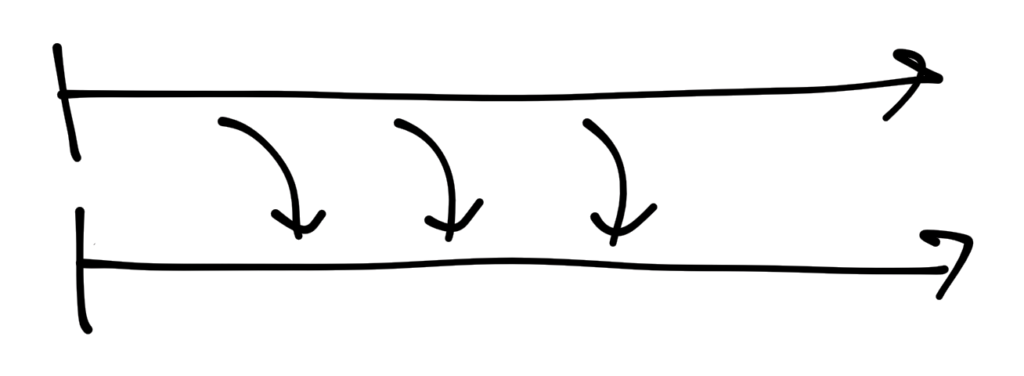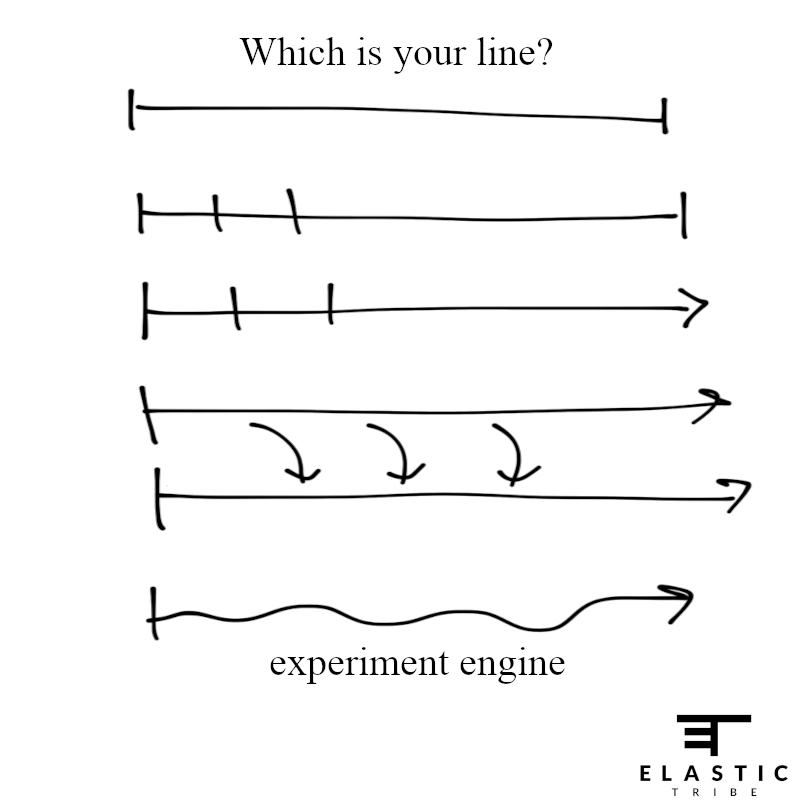The convergence of discovery and delivery
Forecasting the future is fun.
With the help of lines we want to explore how we can improve the way we build digital experiences. But first, we need to address the past and the present.
We begin with a straight line constrained by a start and an end. A project.

Within the time constraints of a project we can add checkpoints to manage progress.

Beyond adding more checkpoints, how do we break free from a project mindset? We replace the vertical bar at the far right with an arrow. A product.

Like projects, products can also have checkpoints.
This was a breakthrough moment in so many ways. A product mindset triggered new frameworks, methodologies, techniques, tools, roles, business models and organisational structures.
Although the line can be infinite, sometimes it hits an end. We believe that a product is led by people interactions (builders and customers) and sometimes there is no longer an alignment.
Do you identify with any of the above lines so far?
Beyond adding markers and an arrow to our starting line, what is next?
In the above lines, delivery has played a prominent role. But discovery is catching up. Strong evidence suggests a shift from time-boxed discovery to continuous discovery. So much so, it is time to fork the product line.

High performing product teams tend to steer away from time-boxed discovery. Instead, they adopt a “dual track” approach. Top track is discovery and bottom track is delivery. Discovery feeds delivery.
Both tracks can have checkpoints. For example, the first draft of a user experience map and release of new API version.
But working across two tracks is not sustainable. Having to make a conscious daily choice to manage your time and energy does not feel natural. There is an opportunity to blur the line between discovery and delivery to promote a greater sense of flow.
It is time to forecast the future.
As technology develops, the speed of change increases. It is no longer sustainable for individuals to remain experts because knowledge can very quickly be made redundant.
Mastering the art of collaboration is the only answer. Organisations need to design the optimal conditions for teams to perform at their absolute best. We need to understand group dynamics, self awareness and self-management.
We want disciplines to collaborate beyond role definitions. We are all capable of contributing value in the infinite opportunity space and technology driven solution space.
If we become a great collaborator, discovery and delivery compete for priority. But rather than choosing one over the other, we can identify common elements.
The element that prevails across discovery and delivery is an experiment. An experiment can be a functional prototype in discovery or a split test at scale in delivery.
So what does the future look like?
Let’s revisit the top line again. We believe in simplicity and propose replacing the far right vertical bar with an arrow. So we open the door to unleash the collective genius to experiment.
We call a single continuous stream of experiments an experiment engine. The focus is no longer time. Instead, we manage progress and learning.
But an experiment engine is better represented as a wavy line rather than a straight line. History has taught us that experimentation is never linear. The journey matters more than the destination.

In the convergence of discovery and delivery the biggest leap is mental. We elevate experiments as the atomic unit of value in a team and between the team and the voice of the customer. A product is the result of experiments. It is the biggest opportunity for survival in a fast paced, emerging and uncertain world.
What do you think?


